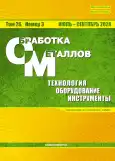Моделирование и оптимизация процесса накатывания роликом Al6061-T6 для достижения минимального отклонения от круглости, минимальной шероховатости поверхности и повышения ее микротвердости
- Авторы: Двиведи Р.1, Соматкар А.1, Чинчаникар С.1
-
Учреждения:
- Выпуск: Том 26, № 3 (2024)
- Страницы: 52-65
- Раздел: ТЕХНОЛОГИЯ
- URL: https://journal-vniispk.ru/1994-6309/article/view/293451
- DOI: https://doi.org/10.17212/1994-6309-2024-26.3-52-65
- ID: 293451
Цитировать
Аннотация
Ключевые слова
Об авторах
Р. Двиведи
Email: rashmidwivedi29@gmail.com
ORCID iD: 0000-0002-9755-5330
доктор техн. наук, Университет технологий и медицинских наук Шри Сатья Саи, Сехор, Мадхья-Прадеш, 466001, Индия, rashmidwivedi29@gmail.com
А. Соматкар
Email: avinash.somatkar@viit.ac.in
ORCID iD: 0000-0002-2885-2104
доктор техн. наук, профессор, 1. Университет технологий и медицинских наук Шри Сатья Саи, Сехор, Мадхья-Прадеш, 466001, Индия; 2. Институт информационных технологий Вишвакармы, Кондва (Бадрек), Пуне – 411048, Махараштра, Индия; avinash.somatkar@viit.ac.in
С. Чинчаникар
Email: satish.chinchanikar@viit.ac.in
ORCID iD: 0000-0002-4175-3098
доктор техн. наук, профессор, Институт информационных технологий Вишвакармы, Кондва (Бадрек), Пуне – 411048, Махараштра, Индия, satish.chinchanikar@viit.ac.in
Список литературы
- El-Axir M.H. An investigation into the ball burnishing of aluminum alloy 6061-T6 // Proceedings of the Institution of Mechanical Engineers, Part B: Journal of Engineering Manufacture. – 2007. – Vol. 221 (12). – P. 1733–1742. – doi: 10.1243/09544054JEM818.
- Klocke F., Liermann J. Roller burnishing of hard turned surfaces // International Journal of Machine Tools and Manufacture. – 1998. – Vol. 38. – P. 419–423. – doi: 10.1016/S0890-6955(97)00085-0.
- Murthy R.L., Kotiveerachari B. Burnishing of metallic surfaces – a review // Precision Engineering. – 1981. – Vol. 3. – P. 172–179. – doi: 10.1016/01416359(81)90010-6.
- Korzynski M. Modeling and experimental validation of the force–surface roughness relation for smoothing burnishing with a spherical tool // International Journal of Machine Tools and Manufacture. – 2007. – Vol. 47. – P. 1956–1964. – doi: 10.1016/j.ijmachtools.2007.03.002.
- Characteristics of Rb40 steel superficial layer under the ball and roller burnishing / H. Hamadache, L. Laouar, N.E. Zeghib, K. Chaoui // Journal of Materials Processing Technology. – 2006. – Vol. 180 (1–3). – P. 130–136. – doi: 10.1016/j.jmatprotec.2006.05.013.
- Investigation of the burnishing force during the burnishing process with a cylindrical surfaced tool / H. Luo, J. Liu, L. Wang, Q. Zhong // Proceedings of the Institution of Mechanical Engineers, Part B: Journal of Engineering Manufacture. – 2006. – Vol. 220. – P. 893–904. – doi: 10.1243/09544054B07604.
- Ebeid S.J., Ei-Taweel T.A. Surface improvement through hybridization of electrochemical turning and roller burnishing based on the Taguchi technique // Proceedings of the Institution of Mechanical Engineers, Part B: Journal of Engineering Manufacture. – 2005. – Vol. 219 (5). – P. 423–430. – doi: 10.1243/095440505X3228.
- The effect of burnishing parameters on burnishing force and surface microhardness / H. Luo, J. Liu, L. Wang, Q. Zhong // International Journal of Advanced Manufacturing Technology. – 2006. – Vol. 28. – P. 707–713. – doi: 10.1007/s00170-004-2412-0.
- Development and burnishing characteristics of roller burnishing method with rolling and sliding effects / M. Okada, S. Suenobu, K. Watanabe, Y. Yamashita, N. Asakawa // Mechatronics. – 2015. – Vol. 29. – P. 110–118. – doi: 10.1016/j.mechatronics.2014.11.002.
- Sundararajan P.N., Nagarajan N. Study of internal roller burnishing operation on En8 material // International Journal of Research and Innovation in Engineering Technology. – 2015. – Vol. 1 (12). – P. 10–12.
- Experimental investigation of the effect of roller burnishing process parameters on surface roughness and surface hardness of C40E steel / N. Kumar, A. Sachdeva, L.P. Singh, H. Tripathi // International Journal of Machining and Machinability of Materials. – 2016. – Vol. 18. – P. 185–99. – doi: 10.1504/IJMMM.2016.075470.
- Przybylski W. Integrated production technology of cylindrical surfaces by turning and burnishing // Advances in Manufacturing Science and Technology. – 2016. – Vol. 40 (3). – doi: 10.2478/amst-2016-0014.
- Shirsat U., Ahuja B., Dhuttargaon M. Effect of burnishing parameters on surface finish // Journal of The Institution of Engineers (India): Series C. – 2017. – Vol. 98. – P. 431–436. – doi: 10.1007/s40032-016-0320-3.
- Effect of roller burnishing process parameters on the surface roughness and microhardness for TA2 alloy / X.L. Yuan, Y.W. Sun, L.S. Gao, S.L. Jiang // International Journal of Advanced Manufacturing Technology. – 2016. – Vol. 85. – P. 1373–1383. doi: 10.1007/s00170-015-8031-0.
- Bourebia M., Laouar L.H., Dominiak S. Improvement of surface finish by ball burnishing: approach by fractal dimension // Surface Engineering. – 2017. – Vol. 3. – P. 255–262. – doi: 10.1080/02670844.2016.1232778.
- Luca L., Neagu-Ventzel S., Marinescu I. Effects of working parameters on surface finish in ball-burnishing of hardened steels // Precision Engineering. – 2005. – Vol. 29. – P. 253–256. – doi: 10.1016/j.precisioneng.2004.02.002.
- Cobanoglu T., Ozturk S. Effect of burnishing parameters on the surface quality and hardness // Proceedings of the Institution of Mechanical Engineers, Part B: Journal of Engineering Manufacture. – 2015. – Vol. 229. – P. 286–294. – doi: 10.1177/0954405414527962.
- An investigation of the mechanics of roller burnishing through finite element simulation and experiments / P. Balland, L. Tabourot, F. Degre, V. Moreau // International Journal of Machine Tools and Manufacture. – 2013. – Vol. 65. – P. 29–36. – doi: 10.1016/j.ijmachtools.2012.09.002.
- Ball burnishing application for finishing sculptured surfaces in multi-axis machines / A. Rodríguez, L.N. López de Lacalle, A. Celaya, A. Fernández, A. Lamikiz // International Journal of Mechatronics and Manufacturing Systems. – 2011. – Vol. 4. – P. 220–237. – doi: 10.1504/IJMMS.2011.041470.
- Чинчаникар С., Гейдж М.Г. Моделирование рабочих характеристик и мультикритериальная оптимизация при токарной обработке нержавеющей стали AISI 304 (12Х18Н10Т) резцами с износостойким покрытием и с износостойким покрытием, подвергнутым микропескоструйной обработке // Обработка металлов (технология, оборудование, инструменты). – 2023. – Т. 25, № 4. – С. 117–135. – doi: 10.17212/1994-6309-2023-25.4-117-135.
- Chinchanikar S., Choudhury S.K. Effect of work material hardness and cutting parameters on performance of coated carbide tool when turning hardened steel: an optimization approach // Measurement. – 2013. – Vol. 46 (4). – P. 1572–1584. – doi: 10.1016/j.measurement.2012.11.032.
- Gaikwad V.S., Chinchanikar S. Mechanical behaviour of friction stir welded AA7075-T651 joints considering the effect of tool geometry and process parameters // Advances in Materials and Processing Technologies. – 2022. – Vol. 8 (4). – P. 3730–3748. – doi: 10.1080/2374068X.2021.1976554.
Дополнительные файлы







